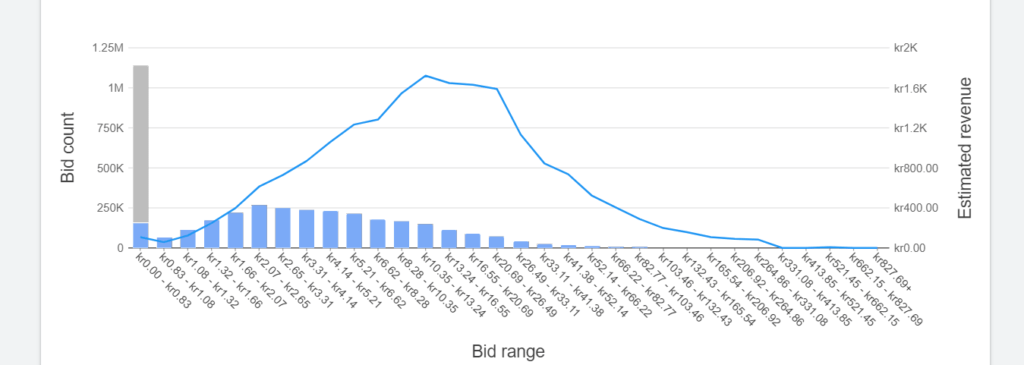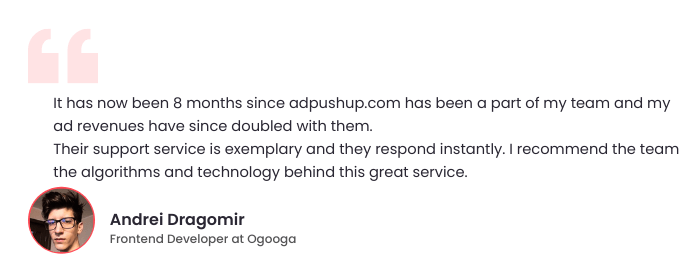This blog talks about how geography impacts price floor optimization. Anurag talked about how publishers can optimize price floors according to geography.
Price floors have been an important concept in the ad tech industry even before real-time bidding emerged. By setting a price floor, publishers can define the quantitative value of their inventory.
But, it isn’t as simple as just setting a price floor and then just letting it be. Publishers have to constantly keep checking what their inventory is worth at a certain time. Due to this, price floor optimization is an important factor for publishers to consider.
Now, price floor optimization is done by paying attention to a number of factors, such as type of devices, ad sizes, seasonality, and audiences. However, we wanted to gain expert insights on how geography impacts price floor.
For this, we consulted Anurag Rai, Sr. Ad Ops Associate at AdPushup, who talked to us about why price floors need to be optimized and what role geography plays in their optimization.
Why Should Publishers Optimize Price Floors?
Anurag rightly said that the programmatic advertising ecosystem is volatile and ever-changing, which is why putting a pin on any setting will probably not help publishers or advertisers. Same is the case with price floors.
“There is no proper structure or guide for setting a price floor- you cannot just decide on one number and say that this number defines the value of this particular inventory. It’s a hit and trial scenario and a lot of experimentation is involved for figuring out what should be the price floor for an inventory at a particular time.’
‘So, what we do is set a price floor, say $2, and check for 2-3 days how many ad requests are being received. If we get only 20 matched requests out of 100 ad requests for a price floor of $2 then we’ll proceed to reduce it to say, $1.7 or $1.8. We basically have to make sure that the inventory is receiving the highest value possible and most of all that it does not remain unfilled.’
‘Price floor basically varies for different publishers. For example, for a small publisher, it is much more important to ensure impressions are filled. However, a large publisher will probably be aware that the value of their inventory is high and therefore, will set a high floor price.’
‘A publisher can check the pricing rules for bid range on their Google Ad Manager dashboard and see what floor price is proving to be the most valuable.”

So, all in all, price floors are highly significant for publishers, and for maximizing ad revenue, they should conduct website analysis at regular intervals for adjusting price floors.
He went on to explain that the value of an inventory is determined by a number of things, such as the traffic on the page, where the traffic is coming from etc, and the discussion moved on to geographical impact on floor prices.
How Geography Impacts Price Floors
Geography has an impact on ad impression revenue and hence is bound to be one of the deciding factors for setting price floors.
“Different geographies can be divided into categories based on the volume of traffic and revenue generated. Quite obviously, countries such as the U.S., the U.K., and Australia can be put in tier 1. Similarly, India can come under tier 2 or tier 3, based on the website.
‘The reason why a lot of publishers cater to the needs of tier 1 geographies is the high internet usage. In addition to this, the purchasing power of people in these countries is high as well. So, if a publisher is looking for earning high ad revenue, tier 1 countries can give high returns.’
‘But there is one more thing to consider while catering to tier 1 countries. Since it is apparent that US or UK traffic, for example, will lead to higher conversion rates, a lot of publishers might be competing for getting high traffic. So, you also have to think about beating the competition for earning more revenue.”
The conclusion that one can draw from this is that publishers have to see what is the best fit for them. If they are getting high traffic from a tier 2 or tier 3 country then they definitely have to set their price floors accordingly. If they instead focus on optimizing their price floor according to the relatively lower traffic that they are getting from a tier 1 country, then their earning capacity might go down.
On an Ending Note
“Publishers should most importantly be aware about the value of their inventory, then only they can put a floor price for that inventory. They have to pull out reports and see what factors, be it geography or ad sizes, are at what position. They further have to know how much advertisers are willing to pay. It is only after considering all such factors that floor prices can be set and timely optimized.”

FAQs
The dynamic price floor optimisation technique is a data-driven pricing strategy that allows publishers to maximize revenue from ads on-time. With this AI-based tool, publishers can set a minimum floor price for their inventory. Opti Yield’s technology.
In setting price floors, geography plays a significant role in determining ad impression revenue. According to the volume of traffic and revenue generated, different geographies can be categorized.
In order for a price floor to be effective, the minimum price must be higher than the equilibrium price. Most governments intervene by establishing price floors to ensure that farmers make enough money by guaranteeing a minimum price at which their goods can be sold.

Shubham is a digital marketer with rich experience working in the advertisement technology industry. He has vast experience in the programmatic industry, driving business strategy and scaling functions including but not limited to growth and marketing, Operations, process optimization, and Sales.








2 Comments
Nice once. I have a question though. Ad req and Match concept is crystal clear. But, my question is more on Ad impressions, may I know why we see less ad impressions even if we have 100 or Match request?
For example: 100 Ad requests 90 Match requests but ad impressions are 30, where we are loosing 60 ad impressions which we can actually monetize.
Any isights would help.
Thanks,
Chintu
Impressions are typically counted later in the ad serving process than Matched Requests. When multiple text ads fill a single display slot it is only counted once, when the top text ad is recognized. In these cases, the Ad Impression is attributed to the top text ad.
The number of Ad Impressions may not exactly match that of Matched Requests. For example, if Ad Exchange wins the opportunity to serve, but the ad doesn’t render successfully, you may have 1 Matched Request and 0 Ad Impressions.
Hope this answers your queries. For any other technical confusions, please feel free to reach out to us at blog@adpushup.com